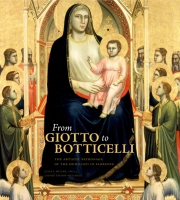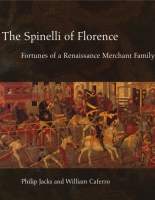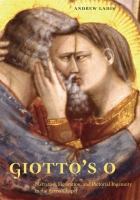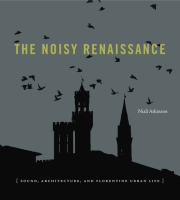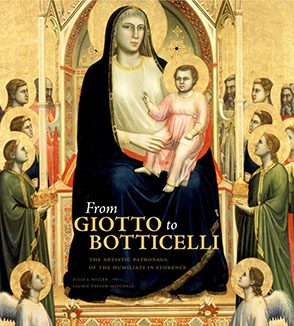
From Giotto to Botticelli
The Artistic Patronage of the Humiliati in Florence
Julia I. Miller and Laurie Taylor-Mitchell
From Giotto to Botticelli
The Artistic Patronage of the Humiliati in Florence
Julia I. Miller and Laurie Taylor-Mitchell
“From Giotto to Botticelli presents a comprehensive study of the Church of the Ognissanti in Florence as a way to better understand the ideology and interests of the Humiliati, a religious order whose art patronage has been unjustly neglected. This fascinating study sheds new light on how the Humiliati shaped art to suit their changing goals as they moved from poverty and humility to secular pleasures and wealth. Sumptuously illustrated, thoroughly researched, and well written, this book convinces the reader of the critical importance of an order whose patronage was momentous for the history of art.”
- Description
- Reviews
- Bio
- Table of Contents
- Sample Chapters
- Subjects
“From Giotto to Botticelli presents a comprehensive study of the Church of the Ognissanti in Florence as a way to better understand the ideology and interests of the Humiliati, a religious order whose art patronage has been unjustly neglected. This fascinating study sheds new light on how the Humiliati shaped art to suit their changing goals as they moved from poverty and humility to secular pleasures and wealth. Sumptuously illustrated, thoroughly researched, and well written, this book convinces the reader of the critical importance of an order whose patronage was momentous for the history of art.”
“From Giotto to Botticelli is a major contribution to the history of Florentine churches. Julia Miller and Laurie Taylor-Mitchell’s fascinating book elucidates how the paintings created for the Humiliati monks at the Church of the Ognissanti represented their religious ideals of charity and humility, even though their monastic order did not always adhere to its stated convictions, was often plagued by controversy, and rarely submitted to reforms.”
“In their well-illustrated and highly readable From Giotto to Botticelli, Julia Miller and Laurie Taylor-Mitchell provide the first account of the Humiliati order’s entire history in Florence. The Humiliati, a mendicant order active in the wool industry, commissioned many masterpieces for their church, the Ognissanti, including Giotto’s Madonna and Child in the Uffizi and his Dormition of the Virgin in Berlin, Donatello’s St. Rossore sculpture in Pisa, and Botticelli’s and Ghirlandaio’s figures of church fathers, still in situ. The authors’ research offers context for understanding these major works of art.”
“Thanks to an attentive, well-documented, very articulated micro-historical reconstruction of the Humiliati’s commissions between 1239 and 1561, this study offers a most rigorous scholarly attempt to identify and explain the distinctive visual features as well as the recurrent iconographies generated by the Humiliati in direct relation to their spiritual mission and devotional practices. . . . The result is very insightful research, in which the authors convincingly demonstrate how the imagery created by the Humiliati reflected and interacted with their deliberate ideological agenda. A pleasure for undergraduates and general readers.”
“Eloquently written and lucidly organized. . . . Miller and Taylor-Mitchell have made a significant contribution to our knowledge of monastic and lay patronage in Renaissance Florence.”
“An important contribution to the study of an often neglected religious order. It will undoubtedly serve as model for future studies on the visual culture of the Humiliati and hopefully, as the book’s appendix surely intends, spur future work on less-studied sites.”
“Lucidly written, logically organized, and handsomely illustrated, From Giotto to Botticelli narrates the founding, rise, and fall of the Humiliati order, specifically exploring the visual strategies used to promote a corporate identity particular to this reformed monastic congregation. Miller and Taylor-Mitchell broaden our understanding of Italian devotional life by going beyond Franciscan and Dominican spirituality, and their book is a welcome complement to recent studies on the Augustinians, Benedictines, Camaldolese, and Carmelites.”
Julia I. Miller is Professor of Art History at the California State University, Long Beach.
Laurie Taylor-Mitchell was Associate Professor of Art History at Hood College. She is currently an engaged activist for public education in Baltimore County.
Contents
List of Illustrations
Acknowledgments
Introduction
1. The Origins of the Humiliati and Their Early History in Florence
2. The Beginnings of Humiliati Art in Florence: Giotto and His Shop at Ognissanti
3. Giovanni da Milano’s Ognissanti Polyptych and Humiliati Art in the Later Trecento
4. The Early Quattrocento at Ognissanti: Donatello and the Cult of Saint Rossore
5. Ghirlandaio and Botticelli in Ognissanti
6. Decline and Disgrace
Epilogue: A Damnatio Memoriae: The Afterlife of the Humiliati
Appendix: Humiliati Churches by City and Dedication
Notes
Bibliography
Index
Introduction
On the evening of October 26, 1569, the thirty-one-year-old archbishop of Milan, Cardinal Carlo Borromeo, gathered with his household in the chapel of the episcopal palace to share evening prayers, as was his custom. A choir singing a motet had reached the words “Non turbetur cor vestrum” (Let not your heart be troubled; John 14:27) when the assembled worshippers were startled by the sound of a gunshot. According to witnesses, a masked figure emerged from the darkness at the top of a staircase and fired a harquebus, an early musket, at the kneeling archbishop from a distance of a few feet. While the attacker fled in the ensuing turmoil, the cardinal, believing he was mortally wounded, calmly finished his prayers, commending himself to God. He was subsequently found to have only a flesh wound, although his garment had been pierced by the shot. By the time of Borromeo’s death in 1584, his escape from harm was considered miraculous, part of the evidence for his canonization.
The drama of this event was heightened by the identity of the unsuccessful assassin, because Girolamo Donati, also known as il Farina, belonged to a venerable religious order called the Humiliati, or “humbled ones.” Moreover, he was part of a broader conspiracy that included three leaders of Humiliati monasteries, who had recruited Fra Girolamo as a hit man. The attempt of 1569 led not only to the arrest and execution of the conspirators but also to the suppression of the entire male branch of the Humiliati in 1571. The assassination attempt was the culmination of an extended conflict between Carlo Borromeo and the Humiliati. The Humiliati order, which centuries earlier had been an important religious force, particularly in northern Italy, had suffered a slow but dramatic decline. With many of its churches and monasteries in ruins and its membership only a fraction of the thousands who had flocked to the order at its height, the remaining Humiliati brothers followed a corrupt life, often eschewing religious dress, engaging in the pleasurable secular pursuits of hunting and feasting, and ignoring even the basic duties of monastic life, such as the recitation of the Divine Office. Cardinal Borromeo’s imposition of church reforms in the 1560s was resisted in equal measure by some of the Humiliati, including the monastic leaders who plotted to kill him.
After their suppression, Humiliati churches and monasteries were turned over to other religious orders, and many of their documents were scattered or lost. In succeeding centuries, the Humiliati were mostly overlooked by scholars, and their colorful history was ignored. It is only quite recently that investigations by modern historians have started to bring Humiliati origins and practices back to life. Yet with few exceptions this renewed interest has not extended to art history. Many contemporary scholars have concentrated on the influence of religious orders—especially the mendicants—on art and architecture, but few have scrutinized works or buildings connected with the Humiliati in relation to their history or ideas. Indeed, the order remains largely unknown to many art historians, especially those writing in English. The misconception that the Humiliati were mendicants, when in fact they became extremely wealthy through their labor and businesses practices, persists in the recent literature.
The purpose of this book is to focus on one establishment, the chiesa di Ognissanti, or church of All Saints, in Florence, as a paradigm for clarifying the patronage and influence of the Humiliati order on works of art commissioned for their churches. The Humiliati entered Florence in 1239 and built their new church of Ognissanti in the 1250s. Over the next three hundred years, the church and its monastery were decorated with paintings and sculptures by some of the leading artists in the city, beginning with Giotto, whose most renowned panel painting—the eponymous Ognissanti Madonna—was made for the church under the aegis of the Humiliati. Two of Giotto’s pupils, Bernardo Daddi and Taddeo Gaddi, were also active in the church, and artists who produced later works in Ognissanti include Giovanni da Milano, Donatello, Sandro Botticelli, and Domenico Ghirlandaio. We will systematically examine these primary works in relation to the history of the order and context of this church and discuss how the ideology and interests of the Humiliati were conveyed within images commissioned for Ognissanti. Many works in Ognissanti cannot be securely documented by surviving contracts or other firm evidence. Nevertheless, we believe the Humiliati either were directly responsible for commissioning the works themselves or had a strong impact on their subjects and visual content. Lay patronage may not have been encouraged in Ognissanti until the later fourteenth century, and even after that time the Humiliati seem to have retained control of many spaces and altars in their church.
The earliest surviving works of art for Humiliati churches, including those in Florence, cannot be dated before the early fourteenth century. Yet even by the early Trecento, the initial ideal of the order—dedication to a humble and penitential life of work and prayer—began to change. The Humiliati moved away from manual labor and toward new goals, such as increasing the numbers of well-trained clerics and support of scholarship. Original Humiliati principles of humility and charity remained important for their art, even as life in Humiliati monasteries became more comfortable and lavish. As time went on, Humiliati art became more didactic and dogmatic, often resembling the imagery and erudite theology generated by the Dominicans. The Dominicans had been involved with the structuring and liturgy of the Humiliati in the thirteenth century, and in Florence, Ognissanti was located only a few blocks away from the roughly contemporaneous great Dominican church of Santa Maria Novella (see map 2). The Humiliati appear to have been aware of the artistic developments in the larger Dominican establishment and even sought to imitate the works commissioned for their imposing neighbor.
This adaptation of forms and themes developed by other religious orders is characteristic of images created for the Humiliati. Although distinctive works were created for the Franciscans and Dominicans, the Humiliati were more followers than innovators. Historically, the order had unusual elements defining their origins, including a unique rule, but few later developments in the order were unprecedented. The derivative aspects of Humiliati imagery are paralleled by their appropriation of patron saints, such as Bernard and Benedict, since over their long history the Humiliati produced only one, probably apocryphal saint. The lack of a charismatic founder or major saint forced the Humiliati to look elsewhere for a sense of identity that would define them.
In 1561, ten years before the male branch of the order was suppressed after the attempt on Borromeo’s life, the remaining Humiliati in Florence were replaced in Ognissanti by Franciscan Observants, largely through the intervention of Duke Cosimo de’ Medici. Over the next few centuries, the Franciscans succeeded in nearly obliterating the now-reviled Humiliati presence in Ognissanti. Nevertheless, despite tremendous losses, it is possible to reconstruct much of the original decoration within the church and to assess similarities in subjects and compositions in the imagery. In the early sixteenth century, the Ognissanti church would have been an impressive monument to the history and ideals of the Humiliati. Approaching the church from its piazza, fronting on the Arno river, visitors would have seen a glazed terra-cotta relief over the central doorway (fig. 2). The relief, displaying the Coronation of the Virgin above a row of diverse saints, was a fitting reflection of the dedication of the church to All Saints and to the Virgin Mary. Upon entering the church and gazing down the nave, the visitor would have seen two prominent frescoes of the Church Fathers Saint Jerome and Saint Augustine (see figs. 60, 61) located on the tramezzo, or choir screen. Painted in 1480 by Ghirlandaio and Botticelli, the Church Fathers helped to promote the scholarly image of the Humiliati. These frescoes flanked the doorway of the tramezzo, through which the high altar of the church could be seen (see figs. 12, 14). A large and sumptuous polyptych painted in the early 1360s by Giovanni da Milano was still located on this altar in the early sixteenth century (see fig. 25). The altarpiece, showing the Coronation of the Virgin adored by crowds of holy figures, initiated the theme restated by the later Coronation over the doorway to the church.
If visitors then turned around to view the inner façade wall (or counterfaçade) of the church, they would have found two works on either side of the main entrance (see fig. 1, nos. 1, 32). On the right side, the fresco of the Annunciation from 1369 (see fig. 31) imitated the famous miracle-working painting of the same subject in the Florentine church of Santissima Annunziata. On the left side of the counterfaçade was an altar dedicated to Saint Rossore. In 1422, the Florentine Humiliati had transferred the head of this now-obscure saint from Pisa, where his relics had been venerated due to his association with military prowess. The Humiliati soon commissioned Donatello to craft a splendid reliquary of gilded bronze to enclose the relic (see fig. 53), and in 1432 this saint was credited with an important Florentine victory, the Battle of San Romano. This reliquary bust and the fresco opposite, both associated with miracles, turned the counterfaçade into a monument of civic pride and devotion.
Several works by the great painter Giotto, including the Dormition of the Virgin, a relatively small painting placed on an altar on the choir screen, and the large Ognissanti Madonna (see figs. 11, 9), would still have been visible in the church, even if no longer in their original locations. Writers from Lorenzo Ghiberti to Giorgio Vasari described several paintings by Giotto for Ognissanti, demonstrating a venerable artistic heritage in the church and the prosperity of the order. The Ognissanti Madonna also contained specific references to the ideal of humility, the virtue for which the order itself had been named. Once again, the presence of the Virgin Mary adored by saints and angels underscored the dedication of the church to All Saints.
In the following chapters, we elucidate how these and other works expressed ideological and spiritual themes important to the Humiliati. The first chapter presents an outline of Humiliati history, their entrance into Florence and construction of the Ognissanti church. We then investigate the works of art created for Ognissanti in a chronological fashion, in four chapters covering roughly fifty years each, from about 1300 to 1500. The concluding chapter touches briefly on a few sixteenth century works in the church and examines the unhappy conclusion to the order’s history and the transformation of Ognissanti under the Franciscans. Although our focus is upon art in the Florentine church, we also refer to works that survive from other Humiliati churches, in Tuscany as well as in northern Italy.
The methodology used to investigate the visual “ideology” of the Humiliati may be divided into two general categories. First, we identified concepts of particular importance to them, such as the virtues of charity and humility and the promotion of a religious identity. Textual references to charity and humility, the repetition of gestures associated with humility, and spatial changes associated with the Christian paradox of humility—the humbled being exalted—are some of the strategies employed to visualize their ideals. Second, we searched for particular features within Humiliati imagery that were not typical of works produced for other religious orders or that the Humiliati had adapted and changed from models in their sources. Although some of the differences from standard types are subtle, these alterations, we hope to demonstrate, reflect a deliberate agenda promoted by the Humiliati to enhance the reputation of their order—ultimately a futile exercise, in view of their ignominious end and subsequent obscurity.
This is a portion of the original introduction, edited for use on the web.
Also of Interest
Mailing List
Subscribe to our mailing list and be notified about new titles, journals and catalogs.
